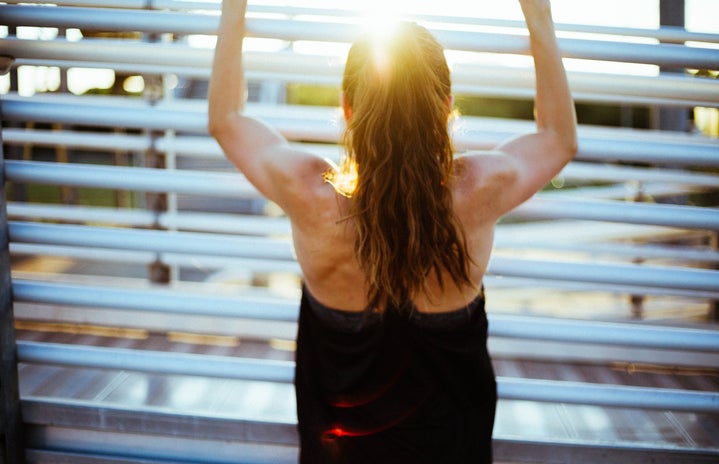It starts out innocently enough. You tan a little too much, sunscreen slips your mind or you figure it’s not the end of the world if you don’t bother reapplying. Next thing you know, the gorgeous skin you’ve been prepping all year to show off this summer has transformed into a dry and inflamed hot mess, and you more closely resemble a lobster than a bikini model.
We all know that we shouldn’t have fun in the sun without protecting our skin, but the truth is, sunburns happen. Luckily, HC consulted a panel of dermatologists and real-life collegiette to bring you the best in sunburn treatment and prevention tips.
What is Sunburn?
So how exactly does skin go from smooth and sunkissed to rough, overheated and peeling, anyway?
“Ultraviolet light, which is radiation, damages skin cells, causing them to die,” Dr. Jeffrey Benabio, a dermatologist and skincare blogger, says. Sunlight consists of ultraviolet radiation, often referred to as UV rays.
Dermatologist Dr. Rachel Herschenfeld says that exposure to the sun’s rays happens even when we aren’t thinking about being in the sun. “UV exposure occurs when people go outside, and even inside through window glass and while driving,” she explains.
Skin cell-destroying UV exposure triggers an inflammatory response in the skin, which causes sunburn. The inflammation is evident in symptoms like redness, tenderness, swelling and peeling of the skin.
Common Sun Mistakes
Even the most skincare-savvy girl makes the occasional fun-in-the-sun faux pas. HC asked collegiettes to share their sunburn stories.
“I neglected to put on sunscreen.”
Alexandra, a junior at the University of New Hampshire, didn’t have much patience for applying sunscreen in her early teen years. Once, on a weekend trip to the beach, Alexandra skipped sunscreen in order to tan. “The hours passed and I was so cold in the water that I didn’t feel my skin burning,” Alexandra says. “When I got out of the water, my whole body started to burn. My skin was taut and red and I felt nauseous the rest of the weekend family vacation.”
“I spent too much time in the tanning bed.”
Jessica, a sophomore at Ohio University, hadn’t tanned for about six months. “I was so excited to start tanning again, I went one day in the tanning bed for fifteen minutes… and then went back the very next day for twenty minutes!” she says. The consequence? “I was so red for the next week, and I could barely sleep because every time I moved in bed, it felt like I had hot needles pricking my skin!” Jessica says.
“I thought darker skin couldn’t burn.”
“I’m half-black and since I have brown skin, everyone (including me) assumes that I can’t burn,” says Danai, a rising sophomore at Harvard. However, she’s been proven wrong: “Whenever I go outside without sun protection on for a while, my skin starts peeling a few days later!” Danai doesn’t experience pain from her sunburns, but she tries to remember to put on sunscreen to avoid the peeling.
Chances are, you’ve been in a situation similar to one of these ladies. Four out of ten people get sunburned at least once a year, the Skin Cancer Foundation reports.
Sunburns can range widely, from slightly irritating to unbearable. Regardless of how bad your burn is, you’re probably itching (no pun intended) to heal and get back to enjoying summer. Read on for expert tips on how to deal with sunburn.
[pagebreak]
Your Plan of Action
“There is no treatment that can shorten the duration of a sunburn,” Herschenfeld says. Instead, you should focus on managing the symptoms while your skin heals. Here’s a breakdown of methods to soothe the symptoms of mild, moderate, and severe sunburns.
Mild (For redness, swelling, tenderness and peeling): According to Herschenfeld, minor sunburns can be treated at home. There are a variety of easy treatment options.
- Cool: Place cool compresses on the affected area to relieve pain, or take a cool bath.
- Medicate: Aspirin or indomethacin, a prescription medicine that helps fight some forms of inflammation, can help reduce the symptoms of sunburn, according to Dr. Cynthia Bailey, a dermatologist and skincare blogger. “They need to be taken prior to or immediately after the sun exposure, before the redness has gotten really bad,” Bailey explains, adding that the drugs work by suppressing inflammation before it starts.
- Moisturize: A mild moisturizing cream, like Aquaphor, will hydrate skin and soothe the burn. In order to maximize the benefits of moisturizer, you should ideally apply it right after bathing the skin in cool water, Bailey says.
- Soak: For a home remedy, dermatologist Dr. Amy Derick recommends a vinegar soak. “Mix a little vinegar and water, soak a washcloth in the mixture, leave it on the skin 10 minutes, then apply Vaseline or Aquaphor,” she says.
- Soothe: Applying aloe vera to the skin is a tried-and-true soothing herbal treatment for sunburn. “Put it in the refrigerator for a day or so before you put it on. It feels so much better,” collegiette™ Jessica suggested. Avoid topical anesthetics like benzocaine and lidocaine because they can cause skin rashes if you’re allergic.
- Protect: Be sure to cover the sunburned skin with loose clothing whenever you go outside. Continue to do so as long as the skin shows visible signs of sunburn or remains painful. Redness will go away in three to four days, but peeling may last about a week.
Moderate (For all of the above symptoms, plus blisters): Try the methods listed above, and whatever you do, don’t pop those blisters! “Blisters should be left intact until they resolve or drain on their own,” Herschenfeld advises. Blisters form to protect raw, damaged skin underneath, so puncturing them will leave the skin vulnerable to infection. The same goes for peeling skin that’s ripped off prematurely, so keep your hands off. (Besides, your roommates will thank you for not grossing them out.) If a blister becomes increasingly painful or discharges thick fluid, it could be infected and should be checked out by a doctor.
Severe (For severe pain, fever, chills, dizziness, vomiting or extensive blistering): If you are experiencing any of these symptoms, you need to see a doctor, Herschenfeld says. The symptoms result from a severe sunburn, also known as sun poisoning. “These patients may need pain medication, IV fluids, or even treatment in a burn unit,” she explains.
Prevention
Your sunburn horror story is bad enough; it doesn’t need a sequel. Take note of the suggestions for summer skincare listed below, and you’ll be ready to keep yourself beautiful and healthy for the rest of the summer (and beyond!).
- Use sunscreen with SPF 30 or higher.You should reapply your sunscreen every two hours, according to Benabio. Not only will you be protecting your skin, you’ll also avoid embarrassing tan lines (you might love your Ray-Bans, but nobody wants a Wayfarer tan imprinted on their face), so apply sunscreen to your face and all other exposed body parts. If you’re concerned about the greasiness of many sunscreens, try oil-free or spray-on sunscreen, and look for makeup with SPF 30 or more.
- Skip the tanning bed. Just like sunlight, the UV radiation found in tanning beds kills the skin cells. If you use it too much, the tanning bed can cause sunburn. “Tanning beds can increase the risk of melanoma by 75%,” Derick says. Melanoma is skin cancer caused by excessive exposure to UV rays. To get a goddess glow without risking your skin, try self-tanner products instead. Some of them even serve double-duty as sunscreen. “I like the Victoria’s Secret tanning products because they allow you to build a tan while protecting your skin from burning,” collegiette™ Alexandra says.
- Ask about your acne meds. Derick explains that some acne medications can make your skin extra sensitive to the sun’s rays. If you plan to spend a lot of time outside, consult your dermatologist to make sure that your medication isn’t putting you at increased risk of sun damage, and adjust your skin protection regimen accordingly. Of course, you shouldn’t apply acne medication to already-sunburned skin.
- Seek the shade.The sun’s rays are strongest between 10 AM and 4 PM, so stay in the shade if you’re out during this time. Instead of meeting your guy for an afternoon frolic in the pool, opt for a romantic walk at sunset. Better yet, spend the evening under the stars! No harmful sun rays involved.
- Wear protective clothing. Rosenfeld suggests wide brimmed hats, sunglasses, t-shirts, long sleeves or light jackets. Too hot out? Try a sexy cover-up over your bikini at the beach and rock a pair of shades every time you go for a stroll or drive.
For more tips, check out Dr. Derick’s video guide to skin protection, and this powerful PSA about melanoma.
Sources
Amy Derick MD, dermatologist
Cynthia Bailey MD, dermatologist and skincare blogger
Jeffrey Benabio MD, dermatologist and skincare blogger
Rachel Herschenfeld MD, dermatologist
College women from across the country

